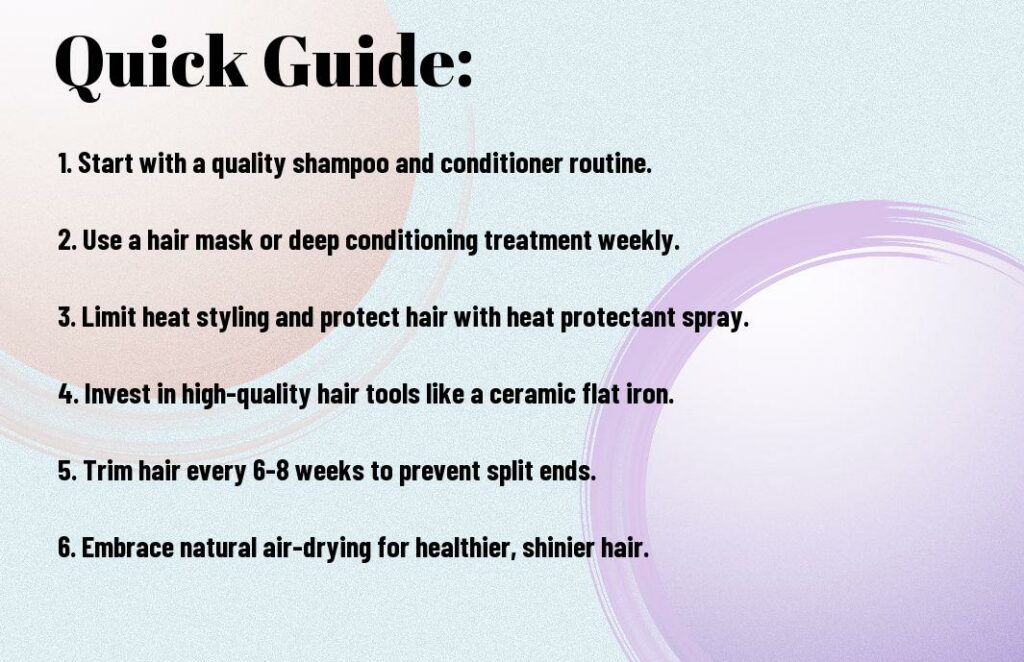Most of us dream of having gorgeous salon-quality hair every day, but achieving that look at home can seem daunting. Luckily, with the right tools, products, and techniques, you can transform your hair into a beautifully styled mane without ever stepping foot in a salon. In this step-by-step guide, we will walk you through the process of achieving salon-quality hair from the comfort of your own home, so you can confidently rock your perfect hairstyle every day.

Understanding Your Hair Type
A crucial step in achieving salon-quality hair at home is understanding your unique hair type. By identifying your hair texture, porosity, and natural tendencies, you can tailor your haircare routine to suit your specific needs and achieve the best results.
Determining Your Hair Texture
One of the first steps in understanding your hair type is determining your hair texture. Hair texture is typically classified as fine, medium, or coarse. Fine hair tends to be delicate and can easily become weighed down by heavy products, while coarse hair is thick and may require more moisture to maintain its health. Medium hair falls somewhere in between the two extremes.
Identifying Your Hair Porosity
You may also want to determine your hair porosity to better care for your strands. Hair porosity refers to how well your hair can absorb and retain moisture. Low porosity hair repels moisture, making it difficult for products to penetrate, while high porosity hair quickly absorbs moisture but struggles to retain it. Understanding your hair’s porosity can help you choose the right products and treatments to keep your hair hydrated and healthy.
Your hair porosity can be determined by conducting a simple test. Take a few strands of clean hair and place them in a bowl of water. If they float, you likely have low porosity hair. If they sink, your hair is more likely to have high porosity. Understanding your hair’s porosity can guide you in selecting the right moisturizing products and treatments to keep your hair healthy and hydrated.
Understanding Your Hair’s Natural Tendencies
An important aspect of understanding your hair type is recognizing its natural tendencies. This includes factors such as how oily or dry your scalp is, how quickly your hair grows, and any specific issues like dandruff or scalp sensitivity. By paying attention to these natural tendencies, you can adjust your haircare routine accordingly to address any specific concerns and promote overall hair health.
Understanding your hair’s natural tendencies can help you choose the right products and treatments to maintain a healthy scalp and promote optimal hair growth. Whether you have an oily scalp that requires frequent cleansing or a dry scalp that needs extra moisture, tailoring your haircare routine to your hair’s natural tendencies can make a significant difference in achieving salon-quality results at home.
Essential Tools and Products for Salon-Quality Hair
Must-Have Hair Care Tools
Even though achieving salon-quality hair at home is possible, you’ll need the right tools to help you along the way. Investing in quality tools like a good hair dryer, a flat iron, a curling wand, and a round brush can make a world of difference in achieving that perfect salon finish. These tools can help you create various styles, from sleek and straight to voluminous curls, right in the comfort of your own home.
Sulfate-Free Shampoos and Conditioners
While traditional shampoos and conditioners may contain harsh sulfates that strip your hair of its natural oils and cause damage, using sulfate-free alternatives can help maintain the health and shine of your locks. Sulfate-free formulas are gentler on your hair and scalp, making them ideal for colored or chemically-treated hair. Look for products that are free of sulfates, parabens, and other harmful chemicals to keep your hair looking and feeling its best.
Products labeled as sulfate-free are formulated without the use of harsh detergents like sodium lauryl sulfate. These shampoos and conditioners gently cleanse and hydrate your hair, leaving it soft, shiny, and more manageable.
Hair Masks and Deep Conditioning Treatments
Tools like hair masks and deep conditioning treatments can take your hair care routine to the next level. These intensive treatments work to nourish and strengthen your hair, improving its overall health and appearance. Incorporating a hair mask or deep conditioning treatment into your weekly routine can help repair damage, restore moisture, and prevent future breakage.
Treatments with ingredients like keratin, argan oil, and coconut oil can help hydrate and repair your hair, leaving it looking and feeling silky smooth and healthy.
Styling Products for Added Hold and Shine
Hair styling products like mousses, gels, serums, and hairsprays can help you achieve the perfect style with added hold and shine. These products can be used to add volume, tame frizz, define curls, or create sleek looks. Choosing the right styling products for your hair type and desired look can make a significant difference in the final result.
Conditioning serums and shine sprays can add a lustrous finish to your hairstyle, making it look professionally styled and polished. These products can also protect your hair from heat damage while adding a healthy shine.
Step-by-Step Guide to Washing and Conditioning
Not everyone has the time or resources to visit the salon regularly for a professional hair treatment. However, with the right techniques and products, you can achieve salon-quality hair at home. One of the crucial steps in your hair care routine is washing and conditioning your hair properly. Follow this step-by-step guide to get the luxurious locks you desire.
Pre-Wash Preparation
| Step | Tip |
| 1 | Before shampooing, detangle your hair with a wide-tooth comb to prevent breakage. |
| 2 | Apply a pre-shampoo treatment or oil to nourish and protect your hair before washing. |
Washing Your Hair Like a Pro
| Step | Tip |
| 1 | On wet hair, apply a small amount of shampoo to your scalp and massage gently. |
| 2 | Rinse thoroughly with lukewarm water to remove all traces of shampoo. |
On top of following these steps, make sure you choose a shampoo that is suitable for your hair type. If you have oily scalp, opt for a clarifying shampoo, while those with dry hair should choose a moisturizing formula.
Conditioning Techniques for Optimal Moisture
| Step | Tip |
| 1 | Clearly, apply conditioner from mid-length to the ends of your hair, avoiding the roots. |
| 2 | Leave the conditioner on for a few minutes to allow it to deeply nourish your strands. |
Conditioning your hair is vital to maintain its softness and manageability. Choose a conditioner that matches your hair concerns, whether it be for hydration, repair, or volume.
Rinsing and Towel-Drying for Minimal Damage
| Step | Tip |
| 1 | While rinsing, use cool water to seal the hair cuticle and add shine. |
| 2 | Gently pat your hair with a soft towel to remove excess water, avoiding rubbing which can cause breakage. |
While towel-drying, be careful not to rough up the hair cuticle, as this can lead to frizz and damage. Instead, wrap your hair in a towel or use a microfiber towel to gently squeeze out the moisture.
Understanding the proper techniques for washing and conditioning your hair is key to achieving salon-quality results at home. By following these steps and tips, you can ensure that your hair stays healthy, shiny, and beautiful between salon visits.
Factors Affecting Hair Quality at Home
Water Temperature and Its Impact on Hair
To maintain salon-quality hair at home, one of the most critical factors to consider is the water temperature you use when washing your hair. The temperature of the water can have a significant impact on the health and appearance of your hair. Here’s a breakdown of how water temperature affects your hair quality:
| Warm Water | Cold Water |
| Helps to open up the hair cuticles, allowing for better cleansing. | Closes the hair cuticles, resulting in smoother and shinier hair. |
Assume that using lukewarm water is a good balance between the two extremes and can help you achieve clean and shiny hair without stripping it of its natural oils.
The Importance of Regular Trims
For maintaining salon-quality hair at home, regular trims are vital. Trimming your hair every 6-8 weeks helps to prevent split ends and breakage, keeping your hair looking healthy and full of life.
Plus, regular trims also promote hair growth by removing damaged ends, allowing your hair to grow stronger and longer over time.
How Humidity Affects Your Hair
The humidity levels in your environment can have a significant impact on the quality of your hair. High humidity can cause hair to frizz and lose its style, while low humidity can make hair dry and brittle.
The key is to strike a balance by using products designed to protect your hair from humidity and using styling techniques that can help your hair withstand changes in humidity levels.
Protecting Your Hair from Heat Styling Damage
With the rise of heat styling tools in home hair care routines, it’s vital to protect your hair from heat damage. Using heat protectant products before styling and avoiding excessive heat exposure can help maintain the quality of your hair.
Hair that is regularly exposed to high temperatures without protection can become dry, damaged, and prone to breakage. By taking steps to protect your hair from heat styling damage, you can keep your hair looking salon-quality at home.
Tips for Achieving Salon-Quality Styles at Home
Keep these tips in mind to help you achieve salon-quality styles in the comfort of your own home:
- Mastering the Art of Blow-Drying: On freshly washed hair, start by gently towel-drying your hair to remove excess water. Apply a heat protectant spray to prevent damage, then divide your hair into sections for easier styling. Use a round brush to lift the roots and create volume as you blow-dry. Finish with a blast of cool air to set the style. This will give your hair a smooth and shiny finish.
Styling Techniques for Volume and Texture
The key to achieving volume and texture is in the styling techniques you use. By incorporating techniques such as backcombing, curling, and using volumizing products, you can create full-bodied and textured styles that mimic salon looks. The use of a root-lifting spray or mousse can help you achieve volume at the roots, while texturizing sprays or dry shampoos can add definition and movement to your hair. Experiment with different styling methods to find what works best for your hair type and desired look. Plus, don’t forget to use the right tools such as a curling iron or straightener to add waves or curls for extra texture and dimension.
Creating a Salon-Quality Updo
Salon-quality updos can elevate your look for special occasions or just to add a touch of sophistication to your everyday style. By following a few key techniques, you can create elegant updos that rival those done by professionals. SalonQuality updos often involve strategic twisting, braiding, and pinning to secure the style in place. You can add accessories like hairpins or jeweled clips to enhance the look and make it stand out even more. Techniques such as creating a sleek bun or a messy bun can help you achieve different levels of elegance for various events or outfits. Don’t be afraid to experiment with different styles to find the perfect updo that suits your hair length and texture.
Finishing Touches for a Polished Look
The finishing touches are what take your hairstyle from good to great. This includes using a high-quality hairspray to set your style in place and add shine. You can also use a shine serum or hair oil to tame frizz and add a glossy finish to your hair. Achieving a polished look also involves paying attention to details such as smoothing down any flyaways or baby hairs, and ensuring that your part is straight and neat. These small details can make a big difference in the overall appearance of your hairstyle.
Weighing the Pros and Cons of At-Home Hair Care
Now, let’s consider the pros and cons of taking care of your hair at home. This comparison can help you decide whether at-home hair care is the right choice for you. Below is a breakdown in the table:
| Pros | Cons |
| Cost-effective | Limited professional expertise |
| Convenience | Potential for mistakes |
| Comfort of your own space | Lack of access to professional products |
Cost-Effective Benefits of At-Home Hair Care
Some of the cost-effective benefits of at-home hair care include saving money on salon visits, reducing transportation costs, and avoiding pricey salon products. Additionally, investing in quality at-home hair care tools and products can save you money in the long run, as you can use them repeatedly for multiple treatments.
Time-Saving Advantages of DIY Hair Care
Clearly, one significant advantage of at-home hair care is the time-saving aspect. You no longer need to commute to a salon, wait for your appointment, and spend hours getting your hair done. With at-home hair care, you can manage your time more efficiently and fit in a hair treatment whenever it suits you best. An necessary consideration regarding time-saving advantages of DIY hair care is that you have the flexibility to schedule your hair treatments at your convenience. Whether it’s early morning or late at night, you can pamper your hair without worrying about salon hours or availability.
Potential Drawbacks of At-Home Hair Care
Benefits of at-home hair care include the ability to personalize your routine for your specific needs, the comfort of your own space, and the freedom to experiment with different styles and treatments without judgment. Additionally, at-home hair care allows you to take control of your hair health and learn more about proper maintenance techniques.
With all these amazing benefits, you can achieve salon-quality hair right from the comfort of your own home. So, whether you choose to visit a salon or take the DIY route, always prioritize the health and well-being of your hair. Keep in mind, your hair is your crowning glory, and it deserves all the care and attention you can give it.
Summing up
Following this step-by-step guide will help you achieve salon-quality hair at home, saving you time and money. By investing in quality products, mastering the techniques of washing, conditioning, styling, and finishing, and caring for your hair between washes, you can maintain healthy and beautiful hair without frequent trips to the salon. Do not forget, practice makes perfect, so don’t get discouraged if you don’t get it right the first time!



